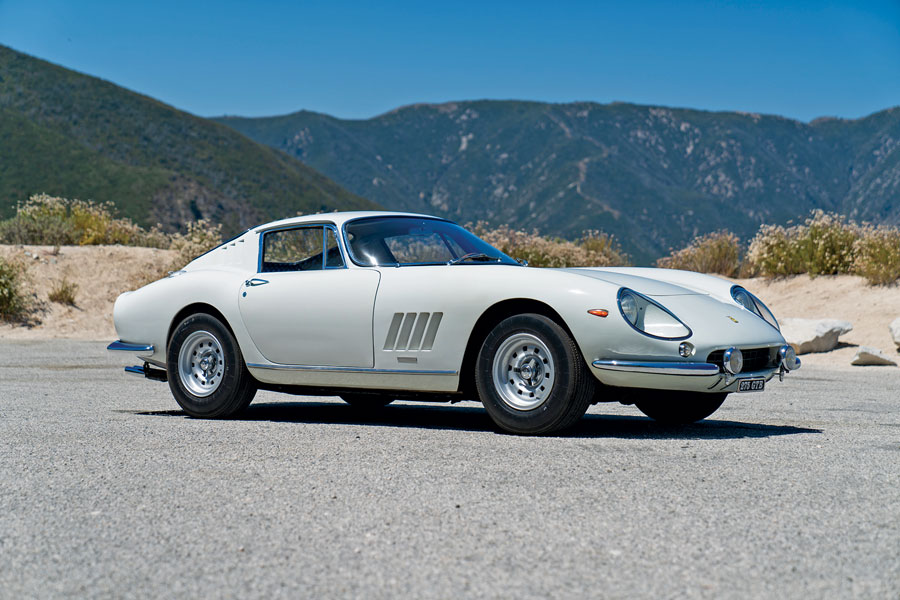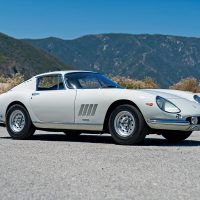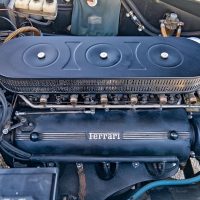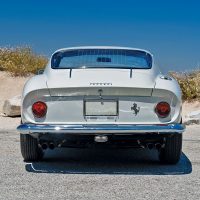SCM Analysis
Detailing
| Years Produced: | 1964–66 |
| Number Produced: | 440 |
| SCM Valuation: | $2,746,000 |
| Tune Up Cost: | $2,000–$3,000 |
| Chassis Number Location: | Right front chassis rail by top of shock mount |
| Engine Number Location: | Right side near starter motor, back of block |
| Club Info: | Ferrari Club of America |
| Website: | http://www.ferrariclubofamerica.org |
| Alternatives: | 1956–57 Jaguar XK-SS, 1966–69 Lamborghini Miura SV, 1959–63 Aston Martin DB4GT |
| Investment Grade: | A |
This car, Lot 56, sold for $3,080,000, including buyer’s premium, at Gooding & Company’s Geared Online auction, August 7, 2020.
We’ll get to this car in due course, but first a digression on one of the features most identified with vintage Ferraris: their gated shifters. Those beautiful chrome-plated gates did not always highlight Ferrari shift levers. Early Ferraris had leather shift boots just like other floor-shift manual-transmission cars. It was not until Ferrari started using rear-mounted transmissions that the beautiful chrome gates showed up on Ferraris. Lamborghini, DeTomaso and a few other marques borrowed the idea, but like a Pepsi is a Coke, all shifter gates are Ferrari shifter gates.
Race-bred transaxle
A rear-mounted transmission is usually part of an assembly known as a transaxle. Operation of a transaxle requires moving gearsets. This can be done manually or with the help of an electronic or hydraulic slave device. In the case of a manually shifted transaxle, the deed is accomplished with a rod that runs from the shifter lever to the transaxle. Intermediate linkage connects the rod to the transaxle. The length and complexity of the assembly can impede precise action.
Precise shifts are helped with controlled movement of the shift linkage. Ferrari learned on their rear-transaxle race cars that a guide plate around the shift lever helped the driver make precise shifts. The 275 GTB was the first production Ferrari to feature a rear transaxle and, accordingly, it was the first production Ferrari to feature the trademark chrome shift gate.
Heir to the 250
There is little argument that the 1950s was the golden age for Ferrari. No other series of cars from any manufacturer was as important as the 250 GT series was to Ferrari. Ferrari built on the 250’s foundation, which led to a legacy of innovation and performance.
The 275 GTB was the first production car to follow the 250 series. It was a major departure from the production 250s and template for the Ferrari berlinettas that followed. Racing had taught Ferrari that a rear transaxle gives a car better weight distribution. It also learned that independent rear suspension allowed better handling than a solid axle rear suspension. Both these attributes were introduced to Ferrari production cars via the 275 GTB, and both features can still be found in modern Ferraris.
The long hood and fastback roofline of the 275 GTB can be traced back to the first Ferraris, but never was the silhouette used as effectively as it was with the 275 GTB. The 275’s covered headlights, Kamm tail and round taillights are classic Ferrari. Add in the one-piece alloy wheels, the first used on a production Ferrari, and the 275 GTB is as timeless as it is beautiful.
Everything but the aluminum
This 275 GTB has all the coveted 275 GTB options except for an alloy body. It’s a six-carb, 2-cam, long-nose, torque-tube example with a rare outside filler cap. It was in the wonderful original condition that many buyers fawn over.
The 275s were built in 2-cam and 4-cam configurations. The 4-cam was the later and more-powerful version. Despite the increased power of the 4-cam engine, many people prefer the looks and engine characteristics of the 2-cam version. Base 2-cam 275s featured three 2-barrel Weber carburetors. A six-carb setup was optional. The six-carb was more expensive and more complicated to maintain. Factory-supplied six-carb cars are relatively rare and add a substantial premium to a 275’s value.
The original 2-cam 275 GTBs are known as short-nose versions. Little of the nose protruded past the headlight covers. Later cars had a longer protrusion and a couple of other changes. The long-nose cars are the most valuable.
Driveshaft vibration could be an issue with early 275s. Ferrari updated later cars with a bearing-supported driveshaft, then went to a shaft that was enclosed in what is called a torque tube. This car has the preferred torque-tube-encased driveshaft.
This car also features an outside competition filler cap. These caps allowed fast fuel refills during races. The fillers have little advantage on street cars other than adding some jewelry. They are, however, quite rare and can add substantial value.
Originality means desirability
“They’re only original once.” I have no idea who coined the phrase, but those four words have become auction gold. Originality makes cars that normally would not get a second look highly desirable. Originality makes truly exceptional original cars record breakers.
This car is described as being in “original” condition. This implies the paint, interior and the majority of the car has not been restored. The auction house provided several images of paint and interior patina to support their claim.
While this original condition would certainly appeal to many buyers, it would certainly turn off many more. Do flaws add character or show neglect? Chipped wheels on a modern Ferrari would indicate neglect. Chipped wheels on a vintage car add character. Bad spots in the paint of a modern car are bad spots. In a vintage car, bad spots are a badge of honor. We say that sometimes a car can be too original, but that line is hard to define.
This 275 was a feature car of Gooding’s premiere online auction. It did not disappoint, landing mid-estimate and earning top-sale honors. It was a deserving car that could not be duplicated. There was little question if the car would be worth the estimate; the question was merely whether there would be two buyers who appreciated what the car was. The answer was yes, and the buyer, seller and the auction company should all be happy with the results. ♦
(Introductory desciption courtesy of Gooding & Co.)




